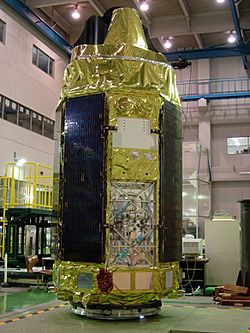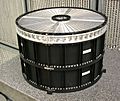Suzaku (satellite) facts for kids

A picture of a fully integrated Astro-E2 before vibration tests at ISAS/JAXA.
|
|
| Mission type | Astronomy |
|---|---|
| Operator | JAXA / NASA |
| Mission duration | Planned: 2 years Actual: 10 years, 1 month, 23 days |
| Spacecraft properties | |
| Manufacturer | Toshiba |
| Launch mass | 1,706 kilograms (3,761 lb) |
| Start of mission | |
| Launch date | 2005-07-10, 03:30:00 UTC |
| Rocket | M-V-6 |
| Launch site | Uchinoura Space Center Uchinoura, Kagoshima, Japan |
| End of mission | |
| Decay date | no earlier than 2020 |
| Orbital parameters | |
| Reference system | Geocentric |
| Regime | Low Earth |
| Perigee | 550 kilometres (340 mi) |
| Apogee | 550 kilometres (340 mi) |
| Inclination | 31 degrees |
| Period | 96 minute |
| Main telescope | |
| Wavelengths | X-ray |

The M-V rocket carrying ASTRO-E veering off course after launch on 10 February 2000.
|
|
| Operator | Institute of Space and Astronautical Science (ISAS) |
|---|---|
| Start of mission | |
| Launch date | 01:30:00, February 10, 2000 (UTC) |
| Rocket | M-V-4 |
| Launch site | Kagoshima Space Center |
Suzaku (すざく) was a special Japanese satellite that studied X-rays from space. It was launched into orbit in 2005.
The mission was a project of the Institute of Space and Astronautical Science (ISAS), which is part of the JAXA. JAXA is Japan's space agency, similar to NASA in the United States.
Suzaku's main goal was to look at very hot objects in the universe. These objects give off X-rays. By studying these X-rays, scientists can learn about things like black holes, galaxy clusters, and the remains of supernovas (exploding stars).
Contents
What are X-rays from Space?
You might know about X-rays from visits to the doctor or dentist. These are a type of light that we cannot see with our eyes. They have a lot of energy.
Space is full of different kinds of light, including X-rays. These X-rays come from some of the most extreme and energetic events in the universe. Earth's atmosphere blocks most X-rays, so we need satellites like Suzaku in space to detect them.
The Suzaku Mission
Suzaku was launched on July 10, 2005. It was carried into space by an M-V rocket from the Uchinoura Space Center in Japan. The satellite weighed about 1,706 kilograms (3,761 pounds).
Once in orbit, Suzaku circled Earth about 550 kilometers (340 miles) above the surface. It completed one orbit every 96 minutes.
The satellite had several special tools to detect X-rays:
- X-ray Telescope (XRT): This helped focus the X-rays.
- X-ray Imaging Spectrometer (XIS): This took pictures and measured the energy of the X-rays.
- Hard X-ray Detector (HXD): This looked for even higher-energy X-rays.
- X-ray Spectrometer (XRS): This tool was designed to measure X-rays with very high precision. Unfortunately, it stopped working shortly after launch.
Suzaku was planned to work for two years, but it kept collecting data for over 10 years! It finally stopped operating in 2015.
The Story of ASTRO-E
Suzaku was actually the second satellite in this series. The first one was called ASTRO-E. It was launched on February 10, 2000.
Sadly, the ASTRO-E mission did not go as planned. The rocket carrying ASTRO-E had a problem. It lost control and veered off course. Because of this, the satellite could not reach its correct orbit. It fell back to Earth and was lost.
Even though ASTRO-E failed, scientists learned a lot from it. They used this knowledge to build Suzaku (which was also called ASTRO-EII). This helped make Suzaku a very successful mission.
Images for kids
See also
 In Spanish: ASTRO-E para niños
In Spanish: ASTRO-E para niños





